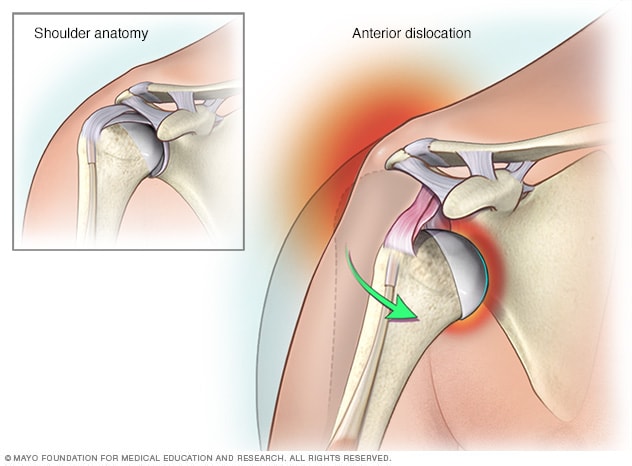Overview
A dislocated shoulder is an injury in which the upper arm bone pops out of the cup-shaped socket that's part of the shoulder blade. The shoulder is the body's most flexible joint, which makes it more likely to dislocate.
If you suspect a dislocated shoulder, seek prompt medical attention. Most people regain full use of their shoulder within a few weeks. However, once a shoulder dislocates, the joint might be prone to repeat dislocations.
Products & Services
Symptoms
Shoulder dislocation

Shoulder dislocation
The shoulder joint is the most frequently dislocated joint of the body. Because it moves in several directions, your shoulder can dislocate forward, backward or downward. The most common variety is a forward (anterior) dislocation.
Dislocated shoulder symptoms can include:
- A visibly deformed or out-of-place shoulder
- Swelling or bruising
- Intense pain
- Inability to move the joint
Shoulder dislocation can also cause numbness, weakness or tingling near the injury, such as in the neck or down the arm. The muscles in the shoulder might spasm, which can increase the pain.
When to see a doctor
Get medical help right away for a shoulder that appears dislocated.
While waiting for medical attention:
- Don't move the joint. Splint or sling the shoulder joint in the position it's in. Don't try to move the shoulder or force it back into place. This can damage the shoulder joint and its surrounding muscles, ligaments, nerves or blood vessels.
- Ice the injured joint. Apply ice to the shoulder to help reduce pain and swelling.
Causes
The shoulder joint is the most frequently dislocated joint of the body. Because it moves in several directions, the shoulder can dislocate forward, backward or downward. It might dislocate completely or partially.
Most dislocations occur through the front of the shoulder. The ligaments — tissue that joins the bones — of the shoulder can be stretched or torn, often making the dislocation worse.
It takes a strong force, such as a sudden blow to the shoulder, to pull the bones out of place. Extreme twisting of the shoulder joint can pop the ball of the upper arm bone out of the shoulder socket. In a partial dislocation, the upper arm bone is partially in and partially out of the shoulder socket.
Causes of a dislocated shoulder include:
- Sports injuries. Shoulder dislocation is a common injury in contact sports, such as football and hockey. It's also common in sports that might involve falls, such as downhill skiing, gymnastics and volleyball.
- Trauma not related to sports. A hard blow to the shoulder during a motor vehicle accident can cause dislocation.
- Falls. Landing awkwardly after a fall, such as from a ladder or from tripping on a loose rug, can dislocate a shoulder.
Risk factors
Anyone can dislocate a shoulder. However, dislocated shoulders occur most often in people in their teens and 20s, particularly athletes involved in contact sports.
Complications
Complications of a dislocated shoulder might include:
- Tearing of the muscles, ligaments and tendons that reinforce the shoulder joint
- Nerve or blood vessel damage in or around the shoulder joint
- Becoming more prone to repeat dislocations, especially if the injury is severe
Stretched or torn ligaments or tendons in the shoulder or damaged nerves or blood vessels around the shoulder might require surgery for repair.
Prevention
To help prevent a dislocated shoulder:
- Take care to avoid falls and other shoulder injuries
- Wear protective gear when playing contact sports
- Exercise regularly to maintain strength and flexibility in joints and muscles
Having a dislocated shoulder joint can increase the risk of future shoulder dislocations. To help avoid a recurrence, keep doing the strength and stability exercises prescribed for the injury.
Aug. 23, 2022